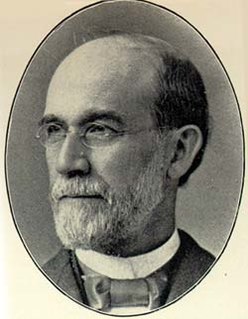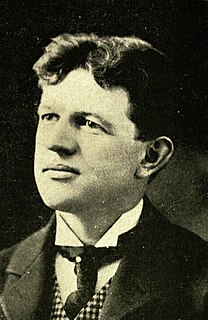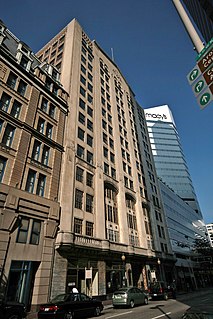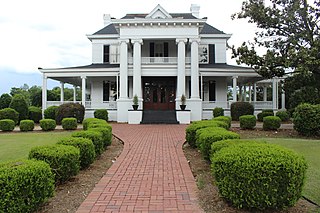


Frank Lockwood (1865-1935) was one of Montgomery, Alabama's leading architects. [1]



Frank Lockwood (1865-1935) was one of Montgomery, Alabama's leading architects. [1]
Lockwood was born in 1865 in New Jersey to English parents. His father was an engineer. Growing up in New York City Frank was a talented singer and was, at one point, offered a contract with the Metropolitan Opera. However, his mother persuaded him to study architecture. After graduating from Princeton University and Pratt Institute he lived in Columbus, Georgia, before moving to Montgomery in 1894. [2]
Lockwood embarked on a 41-year career in Montgomery. He designed scores of residential homes and many important public buildings. He died in 1935 at his home on Adams Avenue. [2]
One of Lockwood's buildings was The Standard Club in Montgomery, designed in 1929. A modern gated community was later built on the site and called Lockwood. [3]
A number of his works are listed on the U.S. National Register of Historic Places. [4]
Works include (with attribution):

Wetumpka is a city in and the county seat of Elmore County, Alabama, United States. At the 2020 census, the population was 7,220. In the early 21st century Elmore County became one of the fastest-growing counties in the state. The city is considered part of the Montgomery Metropolitan Area.

Reuben Harrison Hunt, also known as R. H. Hunt, was an American architect who spent most of his life in Chattanooga, Tennessee. He is considered to have been one of the city's most significant early architects. He also designed major public building projects in other states. He was a principal of the R.H. Hunt and Co. firm.
Henry C. Dudley (1813–1894), known also as Henry Dudley, was an English-born North American architect, known for his Gothic Revival churches. He was a founding member of the American Institute of Architects and designed a large number of churches, among them Saint Paul's Episcopal Cathedral in Syracuse, New York, built in 1884, and Trinity Church, completed in 1858.
William Augustus Edwards, also known as William A. Edwards was an Atlanta-based American architect renowned for the educational buildings, courthouses and other public and private buildings that he designed in Florida, Georgia and his native South Carolina. More than 25 of his works have been listed on the National Register of Historic Places.

Addison Hutton (1834–1916) was a Philadelphia architect who designed prominent residences in Philadelphia and its suburbs, plus courthouses, hospitals, and libraries, including the Ridgway Library and the Historical Society of Pennsylvania. He made major additions to the campuses of Westtown School, George School, Swarthmore College, Bryn Mawr College, Haverford College, and Lehigh University.

Frank L. Packard was a prominent architect in Ohio. Many of his works were under the firm Yost & Packard, a company co-owned by Joseph W. Yost.
Penn Jeffries Krouse, usually known as P. J. Krouse was a prolific architect in the state of Mississippi. Many of his buildings were located in the Meridian area.

John W. Gaddis was a noted architect of Vincennes, Indiana. He designed numerous buildings that are preserved and listed on the National Register of Historic Places.
Albert Anthony Ten Eyck Brown (1878–1940) was an architect active in Atlanta, Georgia and other areas. Brown was born in Albany, New York. He studied at the New York Academy of Design.

Bruce & Morgan was an American architectural firm based in Atlanta. It was established in 1882 as the partnership of architects Alexander Campbell Bruce (1835-1927) and Thomas Henry Morgan (1857-1940).

Albert John Gibson was one of the most prominent and well-known architects in Missoula, Montana who designed a number of buildings that are listed on the National Register of Historic Places.
Charles E. Choate was a U.S. architect who worked in Georgia, Florida, and Alabama. He designed numerous buildings that are listed on the U.S. National Register of Historic Places.

Alexander Blount Mahood was a Bluefield, West Virginia-based architect.
Algernon Blair was a construction contractor in Montgomery, Alabama. He worked on many government building projects including county courthouses and U.S. post offices. He was a member of The Thirteen, a literary and philosophical society. Several of his firm's buildings are listed on the U.S. National Register of Historic Places.

Lockwood, Greene & Company was an American engineering firm. It was active under various names from 1871 to 2017.
Frank E. Wetherell was an American architect in the U.S. state of Iowa who was active from 1892 to 1931. He founded the second oldest architectural firm in the state in Des Moines, Iowa, in 1905. He worked with Roland Harrison in partnership Wetherell & Harrison. The firm designed numerous Masonic buildings.
Edmond Jacques Eckel (1845–1934) was an architect in Missouri. One of his firms was Eckel & Mann. Eckel's name has been spelled with variations including Edmund rather than Edmond and with Jacques spelled as Jaques.

Charles Henry Burggraf (1866–1942) was an American architect primarily working in Salem, Oregon, and Albany, Oregon, who also worked in Hastings, Nebraska, and in Grand Junction, Colorado. A number of his works are listed on the U.S. National Register of Historic Places (NRHP).
Frederick Ausfeld was a US-based, German-born architect. He designed buildings in Montgomery, Alabama, some of which are listed on the National Register of Historic Places.

Thomas Firth Lockwood was the name of two architects in the U.S. state of Georgia, the father and son commonly known as T. Firth Lockwood Sr. (1868-1920) and T. Firth Lockwood Jr. (1894-1963). Thomas Firth Lockwood Sr. came with his brother Frank Lockwood (1865-1935) to Columbus, Georgia, from New Jersey to practice architecture.